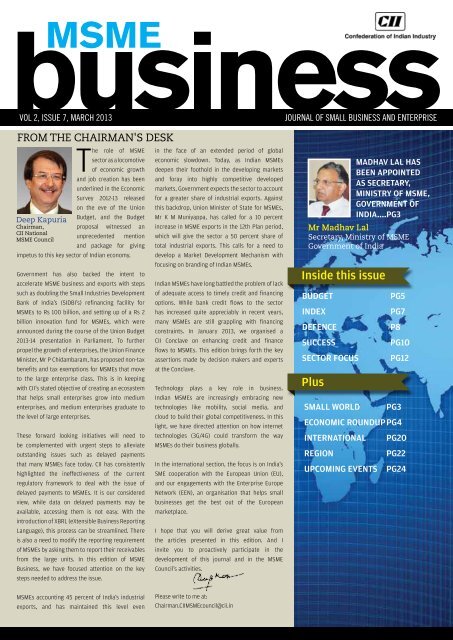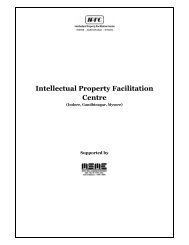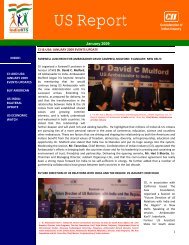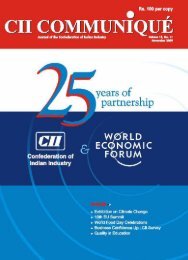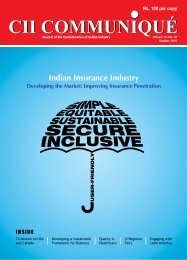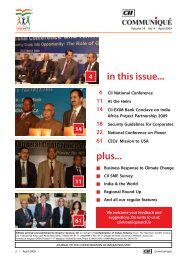Journal of Small Business and Enterprise - March, 2013 - CII
Journal of Small Business and Enterprise - March, 2013 - CII
Journal of Small Business and Enterprise - March, 2013 - CII
You also want an ePaper? Increase the reach of your titles
YUMPU automatically turns print PDFs into web optimized ePapers that Google loves.
<strong>Small</strong> WorldMadhav Lal new MSME SecretaryMr Madhav Lal has been appointedas Secretary, Ministry <strong>of</strong> Micro,<strong>Small</strong> <strong>and</strong> Medium <strong>Enterprise</strong>s(MSME), Government <strong>of</strong> India. He hassucceeded Mr Vivek Rae, who has becomeSecretary in the Ministry <strong>of</strong> Petroleum<strong>and</strong> Natural Gas. Mr Lal, 57, is a 1977-batchIAS <strong>of</strong>ficer <strong>of</strong> J&K cadre. Before joining theMinistry <strong>of</strong> MSME, he was Chief Secretary<strong>of</strong> Jammu <strong>and</strong> Kashmir. He was decoratedthe post <strong>of</strong> the Chief Secretary <strong>of</strong> J&K fora little over two years. Earlier, he wasAdditional Secretary <strong>and</strong> DevelopmentCommissioner, Ministry <strong>of</strong> MSME. Mr Lalhas also served in the Government <strong>of</strong>India as Deputy Secretary in the Ministry<strong>of</strong> Finance (Department <strong>of</strong> EconomicAffairs) <strong>and</strong> as Member (Finance <strong>and</strong>Administration) in the National HighwayAuthority <strong>of</strong> India (NHI).Core Groups to Look into MSME issuesThe Government <strong>of</strong> India hasdecided to form 2-3 small groupsto look into the issues faced by themicro, small <strong>and</strong> medium enterprises(MSME) sector <strong>and</strong> give suggestions. MrAjit Seth, Cabinet Secretary, Government<strong>of</strong> India, has announced the formation <strong>of</strong>2-3 small groups to look into the issuesfaced by MSME sector. MSME sectoris the backbone <strong>of</strong> manufacturing.On immediate basis, I announce theformation <strong>of</strong> 2-3 small groups so thatsuggestions <strong>of</strong>fered here can be lookedinto. This will help us in ascertainingthat what can be done quickly <strong>and</strong> I willtake another review with the Secretariesin three weeks time so that we can dosomething quickly for this sector, MrSeth said in a statement. He stressedon the need for constant technologyupgradation <strong>and</strong> innovation to staycompetitive in the global market. Healso underscored the importance <strong>of</strong>concerted efforts to increase the share <strong>of</strong>MSMEs in these technological areas <strong>and</strong>the necessity for creation <strong>of</strong> intellectualproperty rights.Govt to MonitoringEffectiveness <strong>of</strong>Procurement PolicyThe Ministry <strong>of</strong> Micro, <strong>Small</strong> <strong>and</strong>Medium <strong>Enterprise</strong>s (MSMEs) iscurrently reviewing how muchsuccessful the public procurementpolicy has been during the first one yearafter its implementation. “In the publicprocurement policy, it has been said that20 percent would be procured from MSEsat the end <strong>of</strong> three years. Right now, weare at the end <strong>of</strong> first year. So, we arenow beginning to review with the variousPSUs as to how much they have beenable to procure,” told MSME secretaryMadhav Lal to media. In November 2011,the government approved the procurementpolicy m<strong>and</strong>ating all state-run companies,ministries <strong>and</strong> departments to procure 20percent <strong>of</strong> their products <strong>and</strong> service needsfrom <strong>Small</strong> <strong>and</strong> Medium <strong>Enterprise</strong>s (SMEs).Of the 20 percent target, there is a subtarget<strong>of</strong> four percent that is earmarkedfor procurement from the SMEs owned byentrepreneurs from the Scheduled Castes<strong>and</strong> Scheduled Tribes (SC/ST) communities.SME Collaboration Key to BoostIndia-France Trade: Holl<strong>and</strong>eFocusing on enhancing collaborationbetween Indian <strong>and</strong> French small<strong>and</strong> medium enterprise (SME)sectors is the way forward to give afillip to France-India trade in comingdays, said French President FrancoisHoll<strong>and</strong>e recently. The way forward toboost France-India trade is to focuson collaborations with the small <strong>and</strong>medium enterprises (SMEs) in all sectors<strong>of</strong> the Indian economy, said Holl<strong>and</strong>e,addressing an India-France businessmeet held in New Delhi. The Frenchpresident also said every type <strong>of</strong> Frenchcompany, from the small to the big,should have access to the Indian market.SMEs make up 99.8 percent <strong>of</strong> Frenchbusinesses, while micro-firms accountfor 93 percent. French micro enterpriseshave a higher labour productivity thanmany <strong>of</strong> their counterparts in otherEuropean countries.3MSME <strong>Business</strong> <strong>March</strong> <strong>2013</strong>
BudgetMr Ramesh Datla, Immediate Past Chairman, NationalMSME Council, <strong>CII</strong>Looking at the economic scenario inIndia <strong>and</strong> globally the union budget<strong>2013</strong> was balanced by addressingcertain key issues related to MSMEs. <strong>CII</strong>MSME Council has been pursing for manypolicy changes with the government <strong>and</strong> weare happy that this budget has address some<strong>of</strong> the key issues pursued by <strong>CII</strong> including (i)extending <strong>of</strong> preferential benefits for theMSMEs for 3 years after they outgrow fromtheir existing category, (ii) CSR activity canfund Technology Incubators certified byMinistry <strong>of</strong> S&T <strong>and</strong> MSME, (iii) Rs 500crfor SIDBI to setup factoring guaranteescheme, (iv) doubling <strong>of</strong> allocation toSIDBI. Other key announcements wherethe Rs 2200 fund for tool rooms <strong>and</strong> sectorspecific duty reductions <strong>and</strong> additionalallocation for the NSDC will definitely helpthe MSME's in today's difficult times.Toencourage the listing on SME Exchange,giving support to the start-ups <strong>and</strong> firstgeneration entrepreneurs through listingon SME Exchanges without an IPO is alsoa welcome move. Delayed Payment wasone key issue which was very critical forMSME's in today's environments, has notbeen addressed in this budget.MSME <strong>Business</strong> <strong>March</strong> <strong>2013</strong>6Mr Kavi Arora, CEO & MD, Religare Finvest LimitedThe budget this year has been aprogressive <strong>and</strong> forward lookingone with special mention to MSMEs.Government has realized the financegap to the sector <strong>and</strong> has announcedsome primary steps to bridge this hiatus.Announcements such as non-tax benefitsfor three years, more funds to SIDBIto support refinancing <strong>and</strong> factoring,extension <strong>of</strong> technology fund scheme(TUFs) for textile industry, fund <strong>of</strong> Rs.2200 cr for tool-room <strong>and</strong> technologydevelopment <strong>and</strong> lower interest for h<strong>and</strong>loomweavers, will all add to the motivationfor this sector. Especially for textiles whichcontributes to almost 10% for the totalmanufacturing output from MSMEs inIndia, this announcement <strong>of</strong> providingtechnology support will give an impetusto the sector. I believe sector focusedNBFCs like us had some more expectationsin terms <strong>of</strong> special incentives <strong>and</strong> costbenefits to service MSMEs in India, thatare not directly covered in this budget buthopefully we can get some refinancingbenefits from funds allotted to SIDBI.Mr P Ganesh, Chairman MSME Sub-Committee SR &Chief Executive GEFAB Facade Solutions P Ltd<strong>CII</strong> should strongly take up extending thebenefit <strong>of</strong> 15% investment allowanceto MSMEs also by withdrawing the minlimit <strong>of</strong> 100 Crores proposed in the budget.Incentivize the MSME sector basedon performance. Most <strong>of</strong> units in thesector become sick due to high cost<strong>of</strong> finance. Encourage more number <strong>of</strong>units to establish shop, produce <strong>and</strong> sell.MSME sector is the largest employmentgenerator in India after agriculture. A smallpercentage <strong>of</strong> the indirect taxes paid (ED,CST, VAT, Service Tax) by the unit may beused to incentivize the unit say 8 to 10%.Mr M Babu Rao, Managing Director,GSB Forge Pvt LtdThis provision is rather discriminatory <strong>and</strong>should be done away with for the healthygrowth <strong>of</strong> MSMEs in the country <strong>and</strong> givinga boost to the manufacturing sector.This amount could be used to reduce thecost <strong>of</strong> finance by financial institutions.Only the deserving units will be benefitted.All public sector <strong>and</strong> private sector banksshould be m<strong>and</strong>ated to participate in equity<strong>of</strong> MSME's aspiring to get listed. This will bea great help to the MSME's <strong>and</strong> the financialinstitutions will also get benefited by way<strong>of</strong> good returns. The banks can retire theequity after the lock in period <strong>of</strong> 3 years.
Growth DriverRevving Up For VerticalTake-OffWith global aircraft companies <strong>and</strong> OEMs turning to India for assured suppliesat competitive costs, niche SMEs operating in the aerospace industry are seeingunprecedented growth opportunitiesMSME <strong>Business</strong> <strong>March</strong> <strong>2013</strong>8Aircraft manufacturing companies<strong>and</strong> large original equipmentmanufacturers (OEMs) areincreasingly turning to Indiansuppliers due to costconsiderations, especially in the wake<strong>of</strong> an extended period <strong>of</strong> globaleconomic slowdown.Moreover, global firms producingcommercial aircraft have cut downdevelopment time using computeraideddesign <strong>and</strong> drafting (CADD),which allows them to design <strong>and</strong> test anentire aircraft, including the individualparts, by computer. The specifications<strong>of</strong> these parts can be sent electronicallyto subcontractors around the worldincluding India who use them toproduce the parts.Emerging OpportunitiesIndian SME manufacturers linkedwith the global aerospace industryare poised to leverage these emergingmarket opportunities. They would alsobenefit from global aerospace suppliersentering into joint venture arrangementswith major Indian aerospace companies.In fact, many traditional first tieraerospace supplier responsibilities arebeing pushed down the supply chain tosecond <strong>and</strong> third tier suppliers. As thelarger firms move into aerospace systemintegration, lower-tier firms are calledupon to globalise themselves.Once established in India, many <strong>of</strong>the first tier firms require their supplychain partners to begin dealing directlywith Indian members <strong>of</strong> the supplychain. While extremely challenging forSME suppliers, these new relationshipsbring an added benefit, the opportunityfor additional sales with other aerospacecompanies doing business in India.The SMEs are also seeing a raft<strong>of</strong> opportunities springing from theexpansion <strong>of</strong> India's own aerospaceindustry, with all its segments includingcivil aviation, military aviation <strong>and</strong> spaceresearch showing remarkable growth.Renewed thrust on modernisation <strong>of</strong>airports, communication, navigation<strong>and</strong> surveillance systems for aircraftmanagement <strong>and</strong> facilities formaintenance repairs <strong>and</strong> overhaul(MRO) <strong>of</strong> aircraft <strong>and</strong> subsystems arecreating new growth opportunities forthe SMEs operating in this industry.Ministry <strong>of</strong> Civil Aviation, Government<strong>of</strong> India, has estimated that the Indianaerospace industry needs investment <strong>of</strong>$200-$300 billion. A major pro<strong>of</strong>-pointthat the industry has set sights on a veryhigh growth trajectory.India also represents a large <strong>and</strong>growing annual market for air defenceequipment with major procurement<strong>of</strong> military hardware <strong>and</strong> also forupgrading its surveillance, defence <strong>and</strong>strike capabilities.The Defence Offset Policy has alsospurred Indian SME to address the globalaerospace value chain. Informationtechnology systems, simulators, <strong>and</strong>such advances are coming into defencein a big way.Also, the scope <strong>of</strong> <strong>of</strong>fset policyguidelines has been exp<strong>and</strong>ed toinclude civil aerospace, internalsecurity <strong>and</strong> training. The list <strong>of</strong> eligible<strong>of</strong>fset obligations will cover most aspects
Growth Driver<strong>of</strong> civil aerospace including aircraft, airengines, aircraft components, design,engineering services, etc. A widerange <strong>of</strong> weapons <strong>and</strong> servicesfor counter-terrorism have beenincluded in the list <strong>of</strong> products underinternal security.Niche SMEsHowever, these opportunities areopen only to niche SMEs that have thewherewithal to cater to this market.These niche SMEs are today seeingmultiple opportunities in design,development, <strong>and</strong> manufacturing in theaerospace sector. At the same time, tomove up the global defence value chain,these enterprises should have to focuson innovation, building intellectualproperty, <strong>and</strong> adopt quality <strong>and</strong> processst<strong>and</strong>ards to be able to <strong>of</strong>fer completesub-systems or assemblies.Aerospace manufacturing is ahigh technology <strong>and</strong> capital intensiveindustry. Its value chain is characterisedby a long project life cycle spanningR&D, engineering design, manufacturing,assembly, maintenance, repair <strong>and</strong>overhaul. Intensive technology <strong>and</strong>safety requirements require significantinvestments in R&D <strong>and</strong> quality control.Firms that focus on multipurposetechnology have secured their positionin the market by becoming specialisedsuppliers serving different globalvalue chains. SMEs <strong>of</strong> aerospace <strong>and</strong>precision engineering sectors havebecome conscious <strong>of</strong> their competitivestrengths, which they associate inparticular to flexibility <strong>and</strong> quality<strong>of</strong> their <strong>of</strong>fer.Looking ahead, two key areas thatmerit expeditious interventions areMSME R&D in aerospace industry, <strong>and</strong>talent development for building a globalworkforce for the niche SMEsPrivate sector participation indefence R&D is growing. Governmentshould look to create an ecosystemthat encourages more private playersto pursue high-level R&D in theaerospace industry.Meanwhile, United Nations IndustrialDevelopment Organisation (UNIDO)<strong>and</strong> the Society <strong>of</strong> Indian AerospaceTechnologies <strong>and</strong> Industries (Siati)have partnered to create a longtermdevelopment programme forBangalore-based aerospace SMEs. Thetwo organisations are to help SMEs insub-contracting <strong>and</strong> partnershipexchange, prepare for supplierdevelopment programmes <strong>and</strong> helpthem through matchmaking services viaglobal networks.As regards talent management,the focus for SMEs should be todevelop new employees throughspecialised training programs <strong>and</strong>assimilation, while keeping currentemployees <strong>and</strong> attracting highly skillednew workers to join the workforce. Itis a highly strategic effort <strong>and</strong> takes aconscious effort from management tosource, attract, select, train, develop,promote, <strong>and</strong> move employees throughthe organisation.Way ForwardIndian industry has time to timemade various suggestions to helpSMEs take full benefit from the newdevelopments in the global aerospaceindustry. They are:India should leverage its strengthsin the information technology <strong>and</strong>automotive industries to graduate intodesign, development <strong>and</strong> manufacturingin the aerospace <strong>and</strong> defence sector.Indian SMEs should aim tointegrate into the global aerospace<strong>and</strong> defence value chain throughIndian prime contractors involvedin global defence programs <strong>and</strong>/orbuild relationships with internationalSMEs in niche technology areas.OEMs in the aerospace <strong>and</strong> defencesector are shifting their focusto design <strong>and</strong> systems integration fromvertically integrated manufacturing.This provides an added opportunity toSMEs to venture into areas <strong>of</strong> aerospace<strong>and</strong> defence manufacturing which wereearlier the exclusive domains <strong>of</strong> OEMs <strong>and</strong>large prime contractors.The Indian aerospace <strong>and</strong> defenceindustry needs rapid development <strong>of</strong>domain knowledge. This would requireactive industry-government-academiapartnership with leading technologyinstitutes across the globe, to upgrade,design <strong>and</strong> <strong>of</strong>fer tailor made coursesfor the aerospace <strong>and</strong> defenceindustry in India.SMEs in the aerospace <strong>and</strong>defence industry should focus onbuilding complementary activities <strong>and</strong>capacities <strong>and</strong> sharing common facilitiesthrough clusters.Government may consider focusingon areas <strong>of</strong> strategic importance <strong>and</strong>gradually integrate the private sectorinto non-strategic areas. To enable theprivate sector to plan their investments<strong>and</strong> supply chain in advance, the privatesector could be closely involved inplanning <strong>and</strong> project categorization.Private sector participation indefence R&D should be activelyencouraged <strong>and</strong> primarily financed bythe government, given the fact thatdefence R&D is expensive <strong>and</strong> markedby an element <strong>of</strong> uncertaintyOverall, there is a need to mitigatethe common challenges faced by SMEs,like credit shortage, through urgentpolicy interventions by governmentto support SMEs, which in turn willsustain <strong>and</strong> enhance the businesscompetitiveness.These steps will greatly help theIndian aerospace industry to account fora larger share <strong>of</strong> the $930 billion globalaerospace industry.9MSME <strong>Business</strong> <strong>March</strong> <strong>2013</strong>
SUCCESSMSME <strong>Business</strong> <strong>March</strong> <strong>2013</strong>10There's Value In WasteBangalore-based Daily Dump has developed innovative terracotta products thathelp people manage waste with minimal effortBangalore-based Daily Dump (www.dailydump.org), an innovativeMSME doing business in thearea <strong>of</strong> waste management, hasdemonstrated how a small enterprisecould make a big difference to societyin a short span <strong>of</strong> time without dilutingits business goals <strong>and</strong> pr<strong>of</strong>itability.Daily Dump was founded by PoonamBir Kasturi in 2006 to make an attemptto see if waste in our country can bemanaged better, to regenerate the earth<strong>and</strong> the people.Kasturi studied various compostingmethods <strong>and</strong> experimented withseveral <strong>of</strong> her own techniques beforeintroducing Daily Dump's terracottaproducts that help people do thecomposting at home with minimaleffort. The best way for an individualto help the waste issue in their city isto manage it at source. The Daily Dumpmethod <strong>of</strong> composting does not requireelectricity <strong>and</strong> is done in terracottacomposters. The material needed tolook after <strong>and</strong> maintain the compostingprocess is organic <strong>and</strong> totally chemicalfreelike neem powder, EM, biocullum,lemongrass oil, etc, thus making it ec<strong>of</strong>riendly,she explains.Kasturi started Daily Dump by digginginto her personal funds. Impressed withDaily Dump team's performance in astartup competition, a Netherl<strong>and</strong>sbasedsupport group called SharePeoplesent a marketing expert to guide thecompany in its initial growth phaseGrowth has not come easy to Daily Dumpgiven that it was pioneering a conceptthat would find takers gradually throughawareness building.Speaking about this challenge,Kasturi says, Our biggest challengeis to make composting seem simple,doable <strong>and</strong> fun. It is a very hardthing to do with the price point <strong>and</strong>manufacturing scale we are operatingat. We have monetised a market thatdid not exist previously. And ourchallenge remains, product, production<strong>and</strong> price, with the overarchinggoal on customer convenience.Elaborating on the innovation,she says, When I was prototypingcomposting, I found that terracotta wasthe best material because it was porous<strong>and</strong> controlled the excessive water thatis discharged during decomposition.Also having worked with crafts for a longtime, I had found that the potter's skillswere being lost; potter families no longerwanted their children to continue in thetrade because we had stopped using potsto cook, store or use in our daily lives. SoI thought this would be a great startingpoint, to be able to provide pottersa product that would provide them asteady income; while simultaneouslysolving an urban problem.In the longer run Daily Dumpwould be looking at a considerablylarge market in view <strong>of</strong> the wastemanagement challenges that Indiancities face today. She explains thatbig Indian cities produce about 3,000tonnes <strong>of</strong> waste every day. Eachhousehold generates approximately750-1,500 gm <strong>of</strong> organic waste daily.This works out to be 70% <strong>of</strong> the totalhousehold waste. Each house generatesabout 20% recyclable waste <strong>and</strong> 10%rejects daily in addition to the 70% <strong>of</strong>organic waste that is generated.Most <strong>of</strong> waste generated by households<strong>and</strong> commercial establishments reachdumps that are illegal <strong>and</strong> unscientific,adversely affecting communities <strong>and</strong> thebio-diversity around them. Organic wastemixed with batteries, plastic, tubelights<strong>and</strong> medicine pollutes ground water,soil <strong>and</strong> air. Organic waste is 60% water.The municipal department spends fuel,cartage <strong>and</strong> labour transporting water.If our cities manage organic waste atsource, we could spend tax-payers moneyon more urgent project like schools,health <strong>and</strong> infrastructure, she adds.Organic waste like vegetable scraps,fruit peels, leftover food like bread, rice,dal, bones, pasta, garden clippings, oldenvelopes (without the plastic), kitchentissue paper, etc., can be recycled intocompost by using Daily Dump products.Now, our customers keep 3,500kg <strong>of</strong> organic waste out <strong>of</strong> l<strong>and</strong>fill sitesevery day in Bangalore alone by usingour products, says Kasturi, adding thatmost people have never consideredcomposting as an alternative wastemanagement process. The challenge isto convert them into believers.The other challenge is the widespreadperception <strong>of</strong> waste management assomething that the Government has todo. Daily Dump strives to get peopleto take ownership for managing theirwaste. The team aims to make peopleself-driven composters, not motivated byany extrinsic reward/device, to make it acool activity, rather than a chore.Kasturi's advice to buddingentrepreneurs: Know what you want to do<strong>and</strong> why you want to do it; be clear <strong>and</strong>honest about that <strong>and</strong> then stick with itfor a long time before you give up.
Strategy<strong>Business</strong> Plan: Must for SMEMaking a business plan plays a pivotal role in the success <strong>of</strong> the firm <strong>and</strong> thus needsto be followed with a scientific approachIn today's highly competitive <strong>and</strong>ever-changing market conditions, itis vital for businesses to define theirobjectives, develop strategies, forecastgrowth <strong>and</strong> plan for contingencies. Inother words, create a solid business plan.So what is a business plan <strong>and</strong> why is ituseful for SMEs?A business plan outlines the roadmapto achieve both long <strong>and</strong> short termbusiness objectives. This documentalso states a company's vision, mission<strong>and</strong> financial goals. A plan helps tonot only sharpen business focus <strong>and</strong>prioritize actions, but also gauge actualperformance against business goals.ForAn SME, having a structured businessplan serves two significant objectives:The first objective is to presentbusiness details <strong>and</strong> strategies to externalaudiences prospective investors, financialinstitutions etc. to generate funding,which is essential for growth <strong>and</strong> smoothfunctioning <strong>of</strong> the business.The second objective is to keep theorganizational workforce updated aboutthe future plans <strong>and</strong> goals, <strong>and</strong> theroadmap to achieve these. This helpsin steering the organization towardsits objectives by keeping the businessentrepreneur <strong>and</strong> all the employeesaligned in the same direction. In addition,well-devised business plans provide anoperational framework that allows thebusiness to enjoy distinct competitiveadvantages. This, in turn, results inincreased pr<strong>of</strong>its.How does one create a business plan<strong>and</strong> what should it contain?Making a business plan also plays apivotal role in the success <strong>of</strong> the firm <strong>and</strong>thus needs to be followed with a scientificapproach. Below are the key components<strong>of</strong> a good business plan <strong>and</strong> how oneshould go about developing it :1. Executive Summary: The summaryshould be the reflection <strong>of</strong> the business<strong>and</strong> should help reader to underst<strong>and</strong> thekey facts about the business at a glance.The summary should be kept short, crisp<strong>and</strong> clear. It should fit in a page, unless <strong>and</strong>until some key information such as capitalstructure, prime events etc. have to bementioned. Ideally, this is the section thatwill be made last, after all the followingsections are done.2. Vision, Mission business structure<strong>and</strong> promoter background : This section iswhere you outline your business vision <strong>and</strong>mission clearly, e.g. To become the leadingsupplier <strong>of</strong> springs to the automotiveindustry for a spring manufacturer, or Toprovide the most authentic Chinese cuisinein New Delhi for a Chinese restaurantbeing set up in New Delhi. You should alsogive a description <strong>of</strong> how your businessis structured, i.e. the legal structure (asole proprietorship, a partnership or acompany), <strong>and</strong> a brief description <strong>of</strong> thebackground <strong>of</strong> the promoters education,work experience, etc3. Market sizing, growth prospects <strong>and</strong>competition Firstly, you should define themarket in terms <strong>of</strong> size, structure, growthprospects, <strong>and</strong> other trends. After that,you should list out the key competitorsin the market, <strong>and</strong> an assessment <strong>of</strong> theirrelative strengths <strong>and</strong> weaknesses as well.Many times, you might be able to obtainindustry <strong>and</strong> market data from differenttrade bodies (e.g. <strong>CII</strong>, FICCI, Assocham)or Government agencies <strong>and</strong> institutionsspecially tasked for this (e.g. SIDBI)4. Products <strong>and</strong> Services: This sectioncontains the description <strong>of</strong> the products<strong>and</strong> services that the business will supplyto its customers. Your product pricingshould also be included here5. Sales <strong>and</strong> Marketing: In thissection, you should detail out your sales<strong>and</strong> distribution plans, e.g. which cities/localities will you set up a branch ifnecessary, will you appoint your ownsales force or agents, or is it just directmarketing to businesses, etc6. Operations: This section detailsout the manufacturing process or servicedelivery process <strong>of</strong> the business, includingwhat equipment/machinery will be used, etc7. Organization structure : Here,you should detail out the organizationstructure, roles <strong>and</strong> responsibilities <strong>of</strong>senior management <strong>and</strong> the overallmanpower requirements.8. Financials: The trickiest part comestowards the end, as it is interlinked toall the past steps <strong>and</strong> leads to financialstatements such as Income statement,cash flow statement <strong>and</strong> balance sheet.This section is the backbone <strong>of</strong> the planas the overall capability <strong>of</strong> the businessis mirrored here. Sound financials arekey to raising capital in the form <strong>of</strong>equity or for obtaining loans. If the planis for an existing business, then you willhave to provide historical data as well asfuture projections.How <strong>of</strong>ten does the business plan needto change?A business plan is valid only for a finiteperiod <strong>of</strong> time, i.e. 1-2 years at best. Forthe plan to be effective, it needs to bereviewed regularly, as certain strategiesmight require changes to adapt tochanging market conditions.Some sections <strong>of</strong> the plan, such asmarketing plans, pricing, product <strong>and</strong>service features, etc., change in sync withchanging external factors.However, other sections like thecore business model are less likely tochange <strong>of</strong>ten.Getting help Of course, all this mayseem daunting at first sight! But youwill realize the benefits <strong>of</strong> building abusiness plan in a structured manneras it forces you to think through allthe aspects <strong>of</strong> the business somethingwhich you may not have done before.Also, one can take pr<strong>of</strong>essionalhelp here as well. There are manyChartered Accountants <strong>and</strong> otheradvisors who can help you with this;another option is to ask your financepartner (bank or NBFC) who may bedoing this as a value added service toSMEs (Read more about choosing yourright finance partner here).Kavi Arora is Managing Director & Chief Executive Officerat Religare Finvest Limited Managing the <strong>Small</strong> <strong>and</strong>Medium <strong>Enterprise</strong>s (SME) focused commercial lendingbusiness. For any suggestions <strong>and</strong> feedbacks related tothe article kindly write to marketing.rfl@religare.comMSME <strong>Business</strong> <strong>March</strong> <strong>2013</strong>11
Sector FocusClimbing Growth LadderThe growth in adoption <strong>of</strong> agricultural machinery in the country has been madepossible due to their local manufactureMSME <strong>Business</strong> <strong>March</strong> <strong>2013</strong>12Indian automotive major Mahindra& Mahindra on <strong>March</strong> 6 launched itsRs.300-crore tractor manufacturingplant in Andhra Pradesh's Zaheerabadwith an annual capacity <strong>of</strong> 100,000tractors, claimed to be the biggest in Asia.The plant, some 110 km from Hyderabadin Medak district, also attracted sevencomponent manufacturers who would setup their operations there.This reflects how far the farmmechanization in India has come in thepast 50 years. Tractors were introducedin the country through importation. Thelocal production started in 1961 with atotal production <strong>of</strong> just 880 tractors ayear. Nearly 52 years later, Mahindra &Mahindra's Zaheerabad plant alone plansto manufacture 1,000 units a month,which will be increased gradually, saysPawan Goenka, president, automotive<strong>and</strong> farm equipment sectors, Mahindra& Mahindra Ltd. Goenka adds that theancillary units will play an important rolein this project <strong>and</strong> about 20 such farmimplement SMEs are expected to relocateat the 100-acre compound.The growth in adoption <strong>of</strong> agriculturalmachinery in the country has been madepossible due to their local manufacture.According to Tractors ManufacturersAssociation, Lodhi Road, New Delhi,although there are presently about1,000 major manufacturers <strong>of</strong> farmequipment in the country, the supply<strong>of</strong> crucial components to these unitsis mainly undertaken by <strong>Small</strong> <strong>and</strong>Medium <strong>Enterprise</strong>s (SMEs). While the26,000-crore tractor segment leads thefarm equipment sector, the 3,000-croreIndian farm equipment sector is largelyconcentrated in the unorganised sector.Agricultural machines are reservedfor small-scale units. The dem<strong>and</strong> forirrigation pumps, power tillers, chaffcutters, threshers, reapers, combineharvesters <strong>and</strong> milling & dairyingequipment, etc, has been growing inIndia because <strong>of</strong> a robust rural economy,government subsidies, farm labourshortage, improved availability <strong>of</strong> farmcredit <strong>and</strong> custom hiring.The union budget for 2012-13 withproposed outlay <strong>of</strong> Rs.27,049 crore for theagriculture ministry is expected to furtherspur this dem<strong>and</strong>. The proposed NationalFood Security Act <strong>and</strong> Rs.1,000 crore tosupport a new green revolution in easternstates like Assam, Bihar, Chhattisgarh<strong>and</strong> West Bengal to increase the riceproduction, too, brings good news forSMEs in the farm equipment sector.Programmes like the Rashtriya KrishiVikas Yojana with an outlay <strong>of</strong> Rs.9,954crore for <strong>2013</strong> <strong>and</strong> the National FoodSecurity Mission with the programmeoutlay <strong>of</strong> Rs.2,250 crore are also expectedto work in favour <strong>of</strong> raising productivity <strong>of</strong>the sector.Farm mechanisation is covered underthe government's Agriculture Policy. Itclearly states the benefits <strong>of</strong> agriculturalmechanization should be extended to allcategories <strong>of</strong> farmers <strong>and</strong> to all regions<strong>of</strong> the country to achieve the goal <strong>of</strong> 4percent growth <strong>of</strong> the agricultural sector.It also says that agricultural mechanizationshould lead to reduced costs <strong>of</strong> production<strong>of</strong> different commodities, to increaseincome <strong>of</strong> farmers <strong>and</strong> to impart a priceadvantage to Indian agriculture forcompeting in the international market.This means the SMEs in the sector are setfor an accelerated growth.
Sector FocusThe National Manufacturing Policy,2011 advocates value addition <strong>and</strong>technological depth in manufacturing. ATechnology Acquisition <strong>and</strong> DevelopmentFund would be established for acquisition<strong>of</strong> appropriate technologies includingenvironment-friendly technologies. Thereare also provisions for incentives to clusters,guidelines for st<strong>and</strong>ardization <strong>of</strong> quality,product testing, skill development, accessto capital <strong>and</strong> marketing to enhance globalcompetitiveness <strong>of</strong> Indian manufacturing.SMEs present in farm equipmentclusters including those in Ludhinana,Karnal, Ghaziabad <strong>and</strong> Kanpur in northernregion; Mumbai-Pune, Junagarh, An<strong>and</strong><strong>and</strong> Bhopal in Western region; Hyderabad,Guntur, Anantpur, Kakinada, Chennai <strong>and</strong>Salem in southern India; <strong>and</strong> Calcutta,Vardhaman, Durgapur, Dhanbad <strong>and</strong>Muzaffarpur in eastern part <strong>of</strong> the countryst<strong>and</strong> to benefit from the policy.Farm Machinery Training <strong>and</strong> TestingInstitutes at Budni (MP), Hissar (Haryana),Garladinne (Andhra Pradesh) <strong>and</strong>Bishwanath Chariali (Assam) establishedby the government have also been playinga vital role in integrating farm equipmentSMEs into the global supply chain.The Bureau <strong>of</strong> Indian St<strong>and</strong>ards (BIS)with its network <strong>of</strong> centers <strong>and</strong> laboratoriesin the country is m<strong>and</strong>ated to ensurequality manufacture <strong>and</strong> marketing <strong>of</strong>agricultural <strong>and</strong> industrial products in thecountry. The BIS formulates specifications<strong>of</strong> agricultural machinery <strong>and</strong> otherappliances <strong>and</strong> prescribes test codes.The recommendation <strong>of</strong> the WorkingGroup on MSMEs Growth for the 12th FiveYear Plan aims at giving a new thrustto the MSME sector to enable them toincrease their global footprints. SinceIndian farm machinery sector is morecompetitive due to lower labour wages<strong>and</strong> cost <strong>of</strong> production, the importersfrom various countries find Indian farmequipment sector more attractive.According to Lemken, a Germanfarm equipment manufacturer, theequipment manufactured in India areat least 40 per cent cheaper than thosemade in Germany.With foreign farm equipmentmajors such as Lemken <strong>and</strong> Italy'sMaschio Gaspardo setting up theirmanufacturing units in India, evenas many more are in queue, there isenough opportunity for SMEs in the farmequipment space to grow <strong>and</strong> competein global market, especially when thegovernment is by their side with theNational manufacturing CompetitivenessProgramme (NMCP). However, deliveringquality the investors are lookingfor is imperative.More than 18,000 SMEs in the sectorscattered all over the country fabricateimplements <strong>and</strong> equipment for tractor<strong>and</strong> power tiller manufacturers, usingmaterials from mild steel to mediumcarbon steel. Heat treatment practicesare generally inadequate except in fewindustries manufacturing knife <strong>and</strong>tillage tools, says a research paperfrom the Central Institute <strong>of</strong> AgriculturalEngineering, Bhopal.The answer to such challenges liesin innovation, competitiveness <strong>and</strong>sustainability, <strong>and</strong> making the most <strong>of</strong>the government support in terms <strong>of</strong>technology transfer, patent bank, financialassistance, skill development, testing <strong>and</strong>st<strong>and</strong>ardization <strong>and</strong> global exposurethrough international exhibitions <strong>and</strong>fairs. Some <strong>of</strong> the examples <strong>of</strong> thelatest innovations by SMEs in tools <strong>and</strong>implements segment include zero till seeddrill, strip till drill, raised bed planter,sugarcane cutter planter, rice planter,tractor/power tiller operated rotavator,sunflower thresher, aero blast sprayer,power weeder, etc.Given that the farm equipment sectoris gradually coming into its own, it'shigh time that SMEs get more <strong>and</strong> moreactively involved in economic activitiesalong the global value chain, especially inthe export sector.MSME <strong>Business</strong> <strong>March</strong> <strong>2013</strong>13
TransformationThe Game ChangerFDI in multi-br<strong>and</strong> retail will spur Indian MSMEs to boost their globalcompetitiveness <strong>and</strong> tap into new growth opportunitiesMSME <strong>Business</strong> <strong>March</strong> <strong>2013</strong>14In 2006 Government <strong>of</strong> India allowedFDI in single-br<strong>and</strong> retail to giveconsumers greater access to foreignbr<strong>and</strong>s. However, the entry <strong>of</strong> globalbr<strong>and</strong>s through single-br<strong>and</strong> retailingfailed to increase Indian consumerschoice <strong>of</strong> goods <strong>and</strong> services as mostlyluxury br<strong>and</strong>s took this route.Several foreign retailers <strong>and</strong> br<strong>and</strong>sentered the Indian market throughdifferent routes like wholesale cash<strong>and</strong> carry, wholly-owned subsidiary inmanufacturing, licensing <strong>and</strong> distributionagreements, joint ventures for eachbr<strong>and</strong> (or single-br<strong>and</strong> retail route),franchising <strong>and</strong> commission agents.In the effort to open up the retailsector, Government allowed 51 percentFDI in multi-br<strong>and</strong> retail in September2012, but left it to the state governmentsto permit global retailers to open storesin their respective regions.Government also tweaked thesourcing norms for FDI exceeding 50percent in single br<strong>and</strong> retail, requiringforeign firms, which want a relaxation<strong>of</strong> the 30 percent procurement norms,to set up manufacturing facilities inthe country. Cabinet gave its nod tothe policy in November 2012. However,the policy has been put on hold due topolitical opposition.The situation dem<strong>and</strong>s a carefulscrutiny <strong>of</strong> the likely impact <strong>of</strong> a liberalFDI retail policy on Indian producers,kirana merchants, consumers <strong>and</strong> theworkforce. What emerges is that globally,FDI inflows <strong>and</strong> the presence <strong>of</strong> globalretail majors have not undermined thebusiness interests <strong>of</strong> local retail players.The acceptance <strong>of</strong> any br<strong>and</strong> local orforeign depends on how long it is presentin any particular market.Moreover, consumer dem<strong>and</strong> fora wide variety <strong>of</strong> products <strong>and</strong> br<strong>and</strong>swill prevent any firm from absorbingthe entire market share no matter howsuperior its technology or how low itsprice be even if it is far more efficientthan its average rival. Therefore, FDIcoming into domestic markets cannotallow any firm to gain substantialmarket power.Growing consumer awareness <strong>of</strong>different br<strong>and</strong>s will also increase theoverall consumer spend which in turn willcontribute to the GDP growth.
TransformationMulti-Stakeholder BenefitsFDI in multi-br<strong>and</strong> retail will indeedbenefit industry, producers, kiranamerchants, consumers, <strong>and</strong> the workforcein very many ways. A <strong>CII</strong> survey <strong>of</strong> industryleaders revealed that an overwhelmingmajority (80 percent) <strong>of</strong> the respondentswere in favour <strong>of</strong> FDI in multi-br<strong>and</strong>retail. They also recognised that aliberal FDI policy will greatly benefit theMSME sector.FDI in multi-br<strong>and</strong> retail will alsodrive industry to adopt more consumerorientedpractices including closemonitoring <strong>of</strong> consumer preferences.Consumers who do their purchases atmodern outlets have experienced betterproduct quality, lower prices, one-stopshopping, choice <strong>of</strong> more br<strong>and</strong>s <strong>and</strong>products, better shopping experienceswith family <strong>and</strong> fresh stocks.Moreover, where safety is a key factor,consumers tend to opt for br<strong>and</strong>ed goodsthat are perceived as safe <strong>and</strong> conformingto government regulations. They are alsobetter protected against incidence <strong>of</strong>food adulteration.Organised retail with FDI participationwill help Government to systematicallyenforce the regulatory norms. Thereis greater transparency <strong>and</strong> ease <strong>of</strong>monitoring in the case <strong>of</strong> organised retail,which sets stringent st<strong>and</strong>ards that areexecuted through pre-defined processes<strong>and</strong> technology.<strong>CII</strong>'s considered view is that MSMEproducers will greatly benefit from thesourcing opportunities that stem fromFDI participation in the sector. Accordingto a <strong>CII</strong> survey, FDI in retail will push upsourcing from MSMEs to $298 billion fromthe present value <strong>of</strong> $157 billion.FDI in retail will also help MSMEsin terms <strong>of</strong> gross sales, new orders /contracts <strong>and</strong> overall growth.Besides, a liberal FDI policy will usherin advanced technologies <strong>and</strong> expertisethereby augmenting the supply chainmanagement <strong>of</strong> recipient firms. <strong>CII</strong>maintains that supply chain efficiencieswill help reduce wastage, such as seen infruits <strong>and</strong> vegetables production. This inturn will help government curb inflation<strong>and</strong> bring down the interest rates.FDI in multi-br<strong>and</strong> retail is expected toaugment the business prospects <strong>of</strong> some12 million kirana stores in the country.Merchants who are looking to scale upwill gain access to patience capital whichis relatively scarce in the country. Manymore br<strong>and</strong>s <strong>and</strong> products entering theIndian market can be retailed at thekirana stores.The kirana merchants will also gaineasier access to credit <strong>and</strong> financefacilities, logistics support <strong>and</strong> modernsystems <strong>and</strong> processes that drive upefficiency levels. Pertinent to note thatmany <strong>of</strong> the new-generation kiranamerchants are already using technologieslike mobility, e-commerce <strong>and</strong> socialmedia to run their business <strong>and</strong> meetcustomer expectations.Moreover, according to a <strong>CII</strong> survey,nearly 70 percent <strong>of</strong> the employees inthe retail industry see FDI as a growthopportunity for them. They believe theemployment levels will rise with neworders coming in from around the world.FDI in retail is likely to encourage firms tohire more. Dem<strong>and</strong> for contract labour toowill increase. So the notion about peoplelosing their jobs in the wake <strong>of</strong> FDI in retailis completely unfounded.Way ForwardKeeping in view the key benefitsthat FDI in multi-br<strong>and</strong> retail will likelydeliver, <strong>CII</strong> has recommended a set <strong>of</strong>steps <strong>and</strong> guidelines for seamless foreigninvestments in the sector. They are:Kirana stores can be organised intolarger cooperatives to make them moreattractive for investments.Encourage SMEs supplying to globalretail majors in India to focus upon thequality st<strong>and</strong>ards set by the majors, <strong>and</strong>help them gain deep underst<strong>and</strong>ing <strong>of</strong> thecomplex vendor management systems.Improve public <strong>and</strong> privateinfrastructure around multimodaltransport hubs, warehouses, distributioncenters, mismanaged supply chainswith cold-storage <strong>and</strong> other facilitiesdrive inefficiencies.Empower consumers throughawareness programmes, helping them setthe right expectations from all categories<strong>of</strong> br<strong>and</strong>s <strong>and</strong> products.Bring about changes in legal normssuch as those on zoning, store sizes,opening hours, import taxes whichcan shape the emergence <strong>of</strong> retail <strong>and</strong>select formats.Government <strong>and</strong> industry need to becognizant <strong>of</strong> the fact that FDI in retail cansometimes negatively impact consumers ifcorporate retailers adopt anti-competitivepractices such as predatory pricing. So,the Competition Act 2002 can be furtherstrengthened. Also protect consumersagainst predatory pricing.Simplify <strong>and</strong> streamline thelicensing <strong>and</strong> approval processes, createa single window clearance up to theextent feasible.Ensure uniform implementation <strong>of</strong>updated laws like APMC Act, etc.Update existing laws like Shops <strong>and</strong>Establishment Act to make it audit basedor self reporting.The retail industry in India facesmultiple challenges in terms <strong>of</strong> scale,employability <strong>and</strong> shortage <strong>of</strong> relevantskills. Managing this challenge requiresthe Government to create recognizedcourses <strong>and</strong> industry wide accreditationsfor basic training for entry level employeeswith pre-defined quality st<strong>and</strong>ards;provide an impetus to Governmenteducational establishments to introduceretail programs <strong>and</strong> extend incentives<strong>and</strong> support to retailers to create trainingbodies for development <strong>of</strong> employees.On a larger plane, organised retailindustry in India is expected to grow to$535 billion by <strong>2013</strong> with modern retail(organised retail) accounting for a 10percent share. Experts expect the industryto scale the $1,250-billion level by 2020.MSME <strong>Business</strong> <strong>March</strong> <strong>2013</strong>15
FinanceMSME <strong>Business</strong> <strong>March</strong> <strong>2013</strong>16<strong>Small</strong> Sector to get InclusiveInnovation FundThe fund will be capitalised to an eventual target size <strong>of</strong> Rs 5,000 crore in phases.Initially, it is pegged at Rs 500 crore with an investment <strong>of</strong> Rs 100 crore by theGovernment <strong>of</strong> IndiaThe Government <strong>of</strong> India is inthe process <strong>of</strong> establishingan Inclusive Innovation Fundto build an ecosystem <strong>of</strong>enterprises, entrepreneurship,<strong>and</strong> venture capital that promotes thedevelopment <strong>of</strong> innovative solutionstargeted at the bottom <strong>of</strong> the pyramid.The Inclusive Innovation Fund will bebased on the premise that innovativeenterprises can be pr<strong>of</strong>itable <strong>and</strong> scalable<strong>and</strong> can competitively engage people atthe bottom <strong>of</strong> the economic pyramid.The fund will be capitalised to aneventual target size <strong>of</strong> Rs 5,000 crore inphases. Initially, the fund is pegged at Rs500 crore <strong>and</strong> to kick-start investment aseed money <strong>of</strong> Rs 100 crore will providedby the Government <strong>of</strong> India. Eventually,80% <strong>of</strong> its capital will be sourced fromprivate investors, philanthropists, <strong>and</strong>bilateral <strong>and</strong> multilateral institutions whoshare the objectives <strong>of</strong> the fund <strong>and</strong> theremaining 20% will be provided by theGovernment <strong>of</strong> India.The life <strong>of</strong> the fund has been proposedat 10 years, extendable by up to 3 years. Itwill be managed by a highly pr<strong>of</strong>essionalmanagement team. The team will guidethe fund, <strong>and</strong> its investee companies, toachieving its target returns.``The challenge is not in creating funds<strong>and</strong> various financial schemes, ratherthe challenge lies in creating conduciveoperating environment <strong>and</strong> businessecosystem for sustainable development.And the MSME needs protection from theclutches <strong>of</strong> the creditors by developinginnovative financial products,'' saidMr Vivek Rae, former Secretary, Ministry<strong>of</strong> MSME at a conclave, organized byConfederation <strong>of</strong> Indian Industry (<strong>CII</strong>)on Credit <strong>and</strong> Finance for MSMEs:Securing Credit <strong>and</strong> Finance for MSMEs<strong>and</strong> Entrepreneurs.Mr Rae said MSME sector suffers fromfinancial exclusion <strong>and</strong> lending banks <strong>and</strong>the RBI should be held responsible forthis. There is no mechanism to enforcethe accountability on lending banks forachieving the target <strong>of</strong> reaching to thefinancially excluded small units. The targetis meaningless if the there no penaltyclause for achieving the target.He said that larger enterprises shouldplay a more enlightened leadership forvendor development <strong>and</strong> in integratingsmall sector units into the entirebusiness ecosystem. On the issue <strong>of</strong>ease <strong>of</strong> doing business in the country,he c<strong>and</strong>idly admitted that the countryis placed far below global ranking.He said many <strong>of</strong> the south Asian <strong>and</strong>Asian counterparts have better rankingin ease <strong>of</strong> doing business in a country.Poor credit <strong>and</strong> financial availability isdue to the procedural complexities <strong>of</strong>business <strong>and</strong> governance mechanism.Many <strong>of</strong> the foreign investors shy awayMr CK Mishra,Joint Secretary,Ministry <strong>of</strong> MSMEs,Government <strong>of</strong> IndiaMSMEs need better technology <strong>and</strong> fundsThe two major issues that are prevailing inthe sector are lack <strong>of</strong> technology <strong>and</strong> funds.Better technology will lead to better products,which lead to better pricing, subsequently betterpr<strong>of</strong>itability. The technology is expensive <strong>and</strong>you need funds for buying better technology.Ideally the technology should be made availableby financial institutions. However, the risk is toohigh. A new strategy needs to be developedwhere the sector can convince the financialinstitutions that the funds that are invested forbetter technology will have good returns. Thereis no dearth <strong>of</strong> government schemes <strong>and</strong> tailormadefinancial products specifically designed forthe MSME sector by lending banks. However, thesector is still reeling under the financial crisis. Itis important to make the sector more investorfriendly <strong>and</strong> attractive.
Financefrom investing in India, particularin the small sector because <strong>of</strong>procedural complexities.Talking about access to corpus <strong>of</strong>institutional funds for MSMEs, Mr Satish KKaura, Co-Chairman, <strong>CII</strong> Defence Council,<strong>and</strong> Chairman & Managing Director,Samtel Colour Ltd, said that IndianMSMEs singularly depend on lendingbanks, <strong>and</strong> the key constraints for theMSME growth are huge dependenceon banks, absence <strong>of</strong> institutionalmechanism for raising risk capital <strong>and</strong>no alternative financing options.Mr Kaura said financing ecosystemfor MSME in India is lagging behindglobal financial market. Global trendsindicate that banks are generallyunimpressed by the MSME growth <strong>and</strong>its pr<strong>of</strong>it potential so it is futile to expectrisk capital from the banks. However,globally capital markets are very welldesigned to meet the risk capital needs<strong>of</strong> the small business sector.He suggested that exploring thepossibility <strong>of</strong> alternative financingoptions is needed to solve the riskcapital requirements <strong>of</strong> the MSME sectorin quicker terms <strong>and</strong> help the small unitsstay competitive.Talking about the issue <strong>of</strong> delay inpayments, he said the <strong>CII</strong> is in the process<strong>of</strong> proposing a Governance Code whichwill set a st<strong>and</strong>ard for procurements<strong>and</strong> payments. The Governance Codewill encourage all players in the supplychain system to voluntarily adopt timelysettlement <strong>of</strong> payments <strong>and</strong> improve thecredit management system for creatingan effective market.Mr Kaura said the SME exchangeplatform will help small business unitsin rural areas in generating equity fundsfor expansion. It would eventually helpthe sector grow at a faster rate <strong>and</strong>the multiplier <strong>of</strong> that would be hugeemployment generation in rural areas <strong>and</strong>national wealth creation. For sustainabledouble digit growth, he said innovativefinancing mechanisms are required,particularly for MSMEs in the country.Mr NK Maini, Deputy ManagingDirector, <strong>Small</strong> Industries DevelopmentBank <strong>of</strong> India (SIDBI), said debt credit<strong>and</strong> equity gap is huge in the MSMEsector. The credit gap is around Rs 4.8trillion <strong>and</strong> the equity gap is estimatedat Rs 2.5 trillion. And, from the formalsources the equity available is only Rs10,000 crore.He said the SIDBI was primarily set upfor refinancing banks <strong>and</strong> other lendinginstitutions. However, over the years theSIDBI has gotten into direct financing inMSME sector. The SIDBI has repositionedits business model to fill the financial<strong>and</strong> non-financial gaps in the smallsector <strong>and</strong> for the overall development<strong>of</strong> the sector. The institution has beenfocusing on four niche areas includingrisk capital; receivable financing <strong>and</strong>factoring; sustainable financing <strong>and</strong>financing <strong>of</strong> service sector.Mr Maini said there is a requirement<strong>of</strong> Rs 75,000 crore for fulfilling energyefficient equipment needs <strong>of</strong> MSMEsector. The need based financial productswill help MSME units in adopting energyefficient equipment <strong>and</strong> greenerproduction models. ``The lendingbanks are not in a position to fulfill thisrequirement, so Line <strong>of</strong> Credits (LoCs)are arranged from multilateral agencies<strong>and</strong> routed through the SIDBI,'' he said.Regarding financing <strong>of</strong> servicesector, he said lending banks generallygive credits based on tangible collateralsecurity. However, the service sectorproducts are intangible <strong>and</strong> returnsare cash flow based. He said the wayforward is cash flow based financing <strong>and</strong>develop specialized need based financialproducts for each sector.Mr Maini said,``We realise thatfinancial health <strong>of</strong> a MSME unit dependssignificantly upon the speed at whichtheir receivables are realised. We have,therefore, devised a scheme to mitigatethe receivables problem <strong>of</strong> suppliersbelonging to MSMEs <strong>and</strong> improve thecash flow. However, he said it is importantto have more equity investment fortaking forward the factoring business.''About the risk capital, Mr Maini saidboth the new units as well as growingsmall units face scarcity <strong>of</strong> funds, so theSIDBI provides a certain percentage <strong>of</strong>risk capital <strong>and</strong> remaining amount canbe raised as debt fund from lendingbanks against the risk capital given bythe SIDBI. Besides, SIDBI Venture CapitalLimited, a wholly-owned subsidiary <strong>of</strong>the SIDBI provides growth capital in theform <strong>of</strong> equity through its MSME focusedventure capital funds.Mr Gurpal Singh, Principal Advisor& Head MSMEs, Confederation <strong>of</strong> IndianIndustry (<strong>CII</strong>), said <strong>CII</strong> is committed tosolving the financial problems faced bythe small sector in the country. He saidto take the small sector into next level aclose cooperation <strong>of</strong> all stakeholders inthe ecosystem is required. He said thesituation is a bit dicey as MSMEs are toosmall for big institutional investors toconsider <strong>and</strong> big for not in the ambit <strong>of</strong>micro financing.The concept <strong>of</strong> banking hasundergone enormous changes, he saidas the bank are much more proactivein developing need based financialproducts <strong>and</strong> schemes for MSMEs.The lending banks are in a position tosupport many small units that havegrowth potential.MSME <strong>Business</strong> <strong>March</strong> <strong>2013</strong>17Emerge <strong>of</strong>fers opportunities to informed investorsMr Ravi Tyagi,Head <strong>of</strong> SME Project,National StockExchange IndiaTalking about the SME platform <strong>of</strong>National Stock Exchange he said Emerge<strong>of</strong>fers opportunities to informed investors toinvest in emerging businesses with excitinggrowth plans, innovative business models <strong>and</strong>commitment towards good governance <strong>and</strong>investor interest.This platform will provide capital raisingopportunities to credible <strong>and</strong> fast growingbusinesses with good governance st<strong>and</strong>ards.It will be an ideal platform to raise funds forcompanies on a growth path, but not largeenough to list on the main board.The government, the market regulator(Sebi), the RBI, the SIDBI, insurance companies,the VCs <strong>and</strong> lending banks should cometogether <strong>and</strong> create an ecosystem for creatinga MSME success story.
Finance GapMSME <strong>Business</strong> <strong>March</strong> <strong>2013</strong>18Finance Gap a HugeChallengeWith appropriate policy interventions <strong>and</strong> support to the MSME sector, aconsiderable part <strong>of</strong> the currently excluded dem<strong>and</strong> can be made financially viablefor the formal financial sectorThe overall finance gap in theMSME sector is estimated to beRs 20.9 trillion ($418 billion). Thepotential dem<strong>and</strong> for externalfinance is estimated to be Rs 27.9trillion ($558 billion), while the total financechanneled by formal sources is estimatedto be Rs 7 trillion ($140 billion). The overallfinance (debt <strong>and</strong> equity) gap <strong>of</strong> Rs 20.9trillion ($418 billion) is split into a debt gap<strong>of</strong> Rs 19 trillion ($380 billion) <strong>and</strong> an equitygap <strong>of</strong> Rs 1.9 trillion ($38 billion).The potential dem<strong>and</strong> is estimatedto be Rs 27.9 trillion ($558 billion), afterexcluding entrepreneur's own contributiontowards capital expenditure <strong>and</strong> workingcapital finance (Rs 4.6 trillion; $92 billion).Entrepreneurs finance this need throughinternal accruals, or by leveraging personalresources. Studies on the MSME sectorsuggest that entrepreneurs contributeapproximately 25 percent <strong>of</strong> capitalexpenditure dem<strong>and</strong> <strong>and</strong> 20 percent <strong>of</strong> theworking capital finance dem<strong>and</strong>.The International Financial Corporationstudy estimates that the viable debtgap that can be addressed by financialinstitutions in the near term in themanufacturing <strong>and</strong> services sector isRs 2.15 trillion ($42 billion) <strong>and</strong> Rs 0.78trillion ($16.6 billion), respectively.Manufacturing SectorManufacturing enterprises accountfor 73 percent <strong>of</strong> the sector's viable <strong>and</strong>addressable debt gap. Some <strong>of</strong> the keyreasons for the gap in the sector are:(i) Manufacturing MSMEs <strong>of</strong>tenexperience delays in payments, resultingin considerable capital being tied up inreceivables. Such a situation increasesthe working capital requirement. Forinstance, if the working capital cycle <strong>of</strong>an enterprise increases from 60 days to90 days, the working capital requirementtoo increases by approximately 50percent. Since suppliers credit remainslimited, the working capital dem<strong>and</strong><strong>of</strong> enterprises tends to far exceed theshort-term credit limits allocated byfinancial institutions, resulting in a largefinancing gap.The InternationalFinancial Corporationstudy estimates that theviable debt gap that canbe addressed by financialinstitutions in the nearterm in the manufacturing<strong>and</strong> services sector is Rs2.15 trillion ($42 billion)<strong>and</strong> Rs 0.78 trillion ($16.6billion), respectively.(ii) The problem <strong>of</strong> working capitalshortfall is more severe in export/import-oriented MSMEs. In additionto delayed payments, cash flows <strong>of</strong>the enterprise are also vulnerable tocurrency rate fluctuations, <strong>and</strong> withlimited formal finance, such enterprisestend to be underserved.(iii) <strong>Enterprise</strong>s in the sector als<strong>of</strong>ace challenges in financing growth. Mostmanufacturing enterprises plan growtharound capacity expansion as opposedto productivity enhancement throughprocess efficiencies. Financial institutionsare wary <strong>of</strong> financing regular capacityexpansion as they perceive MSMEs to bevulnerable to economic downturn, whencapacity expansion goes underutilized.Services SectorServices enterprises make up27 percent <strong>of</strong> the overall viable <strong>and</strong>addressable debt gap. Financing is better intraditional services industries such as retail,small transport operators, <strong>and</strong> hospitality,as financial industries have a betterunderst<strong>and</strong>ing <strong>of</strong> these sectors. Some <strong>of</strong> thereasons for gap in the sector are:(i) Traditional services experiencea greater debt shortfall in capitalexpenditure financing compared toworking capital requirements becausethere is a high level <strong>of</strong> cash transactionsin business operations that can be usedto finance working capital needs. Limitedraw material <strong>and</strong> market linkagesmake MSME vulnerable to bull-whipeffect during economic downturns,consequently debt financed capitalinvestment strains the cash flow <strong>and</strong>induces sickness financial institutionsperceive higher debt financed capitalinvestment as risky(ii) Although traditional servicesenterprises <strong>of</strong>ten have access to primarysecurity, they tend to transact mostlyin cash, with limited records <strong>of</strong> theirfinancial transactions. Due to inadequateinformation on financial behavior <strong>of</strong>the enterprise <strong>and</strong> entrepreneur; thesanctioned finance limits tend to be lowerthan what they need.(iii) Financial institutions do nothave reliable financing benchmarksfor the services sector unlike forthe manufacturing sector, for whichthere are benchmarks based onthe recommendations <strong>of</strong> the NayakCommittee. As a result, there is greaterdifficulty in determining the actualfinancing needs <strong>of</strong> different types <strong>of</strong>enterprises in the services sector, leadingto under-financing <strong>of</strong> the sector.
DifferentiatorBoosting MSME Br<strong>and</strong> Power<strong>CII</strong> calls for a Br<strong>and</strong>ing & Export that helps position br<strong>and</strong> Indian MSME globallyAfund to subsidise Indian MSMEsbr<strong>and</strong>ing <strong>and</strong> marketingoperations is the need <strong>of</strong> thehour, according to Mr DeepKapuria, Chairman, <strong>CII</strong> NationalMSME Council. The primary objective<strong>of</strong> such a fund is to promote <strong>and</strong> createinternational awareness <strong>of</strong> the IndianMSME label in markets overseas <strong>and</strong> t<strong>of</strong>acilitate the dissemination <strong>of</strong> knowledge<strong>of</strong> Indian MSME products <strong>and</strong> services.In the backdrop <strong>of</strong> opening up <strong>of</strong> FDIin multi-br<strong>and</strong> retail, the fund will enablepositioning the Indian MSME br<strong>and</strong> globally<strong>and</strong> create new market opportunitiesfor a swathe <strong>of</strong> Indian MSMEs, as foreignretailers that invest in India would berequired to source at least 30 percent <strong>of</strong>their goods from Indian MSMEs.Going forward, the proposed fundwould help MSMEs supplying to globalretail majors in India to focus upon thequality st<strong>and</strong>ards set by the majors, gainfirm underst<strong>and</strong>ing <strong>of</strong> their complexvendor management systems, <strong>and</strong> scaleup as per dem<strong>and</strong>s placed by those firms.Economist Paul Deng has analysedthat firms with advanced technology inthe domestic market compete neck-toneckwith the foreign competitors <strong>and</strong>the inefficient firms are driven out <strong>of</strong> themarket. He has termed this driving out <strong>of</strong>the technologically obsolete firms as thediscouragement effect. This dynamismpromotes innovation <strong>and</strong> competitiveness.In this context, the Foreign InvestmentPromotion Board (FIPB) nod to Swedishfurniture retail giant Ikea to invest in theIndian retail sector is expected to createbusiness opportunities for a variety <strong>of</strong>Indian MSMEs that can supply to thisretail major. Ikea plans to open 25 outletsin India, investing $2 billion over thenext 10-15 years. While initially, Ikea hadexpressed reservations about sourcingfrom Indian SMEs, citing its own complexglobal vendor management processes,the group has now agreed to adhere tothe sourcing norm.It is well recognised that MSMEscontribution to employment generationcannot be understated, <strong>and</strong> therefore thesector deserves unwarranted attentionby the Union Commerce Ministry, whileupdating the Export Import Policy 2009-2014, for the growth <strong>and</strong> development <strong>of</strong>the Indian economy, says Mr Kapuria.While thanking the Finance Minister,Mr P Chidambaram, for taking cognizance<strong>of</strong> the <strong>CII</strong> Pre-Budget Memor<strong>and</strong>umfor MSMEs, Mr Kapuria shared thatout <strong>of</strong> the 12 recommendations madeby <strong>CII</strong>, five recommendations, founda mention in the Union Budget <strong>2013</strong>-14 these include, (i) Continuation <strong>of</strong>the benefits or preferences enjoyed byMSME for up to three years; (ii) Provision<strong>of</strong> a corpus <strong>of</strong> Rs 500 crore to SIDBIto set up a Credit Guarantee Fund forFactoring; (iii) Provision <strong>of</strong> a sum <strong>of</strong>Rs 2,200 crore during the 12th Plan periodto set up 15 additional tool rooms <strong>and</strong>Technology Development Centres; (iv)Funds provided to technology incubatorslocated within academic Institutionswill qualify as CSR expenditure; (v) SMEswill be permitted to list on the SMEExchange without being required tomake an initial public <strong>of</strong>fer (IPO).The Budget's announcements werepredicated to social <strong>and</strong> financialinclusion to catalyse economic growth,according Mr Kapuria.Last year, the Parliamentary St<strong>and</strong>ingCommittee on Commerce, Chaired byMr Shanta Kumar, had suggested thesetting up <strong>of</strong> an export marketing fundwith a corpus <strong>of</strong> at least Rs 1,000 crorefor MSMEs. The committee in its reporttabled in Parliament had mentioned thatto double India's share in world trade by2020, it is necessary to create a robustMSME segment that is oriented to exportpromotion. The panel said a fund shouldbe set up to subsidise the marketingefforts <strong>of</strong> MSMEs.However, <strong>CII</strong> is <strong>of</strong> the view that amarketing fund by itself cannot help theMSMEs tackle all the problems they arefacing now. MSMEs on their own shouldbe willing to adopt modern marketingtechniques to tap the huge marketopportunity that is available to them.Br<strong>and</strong>ing, especially, is a big challengefor MSMEs as it calls for a lot <strong>of</strong> investment,which these firms cannot afford on theirown. To cap it all, there is no fundingavailable for br<strong>and</strong> building activity - fromGovernment <strong>of</strong> the banks. <strong>CII</strong> observesthat without proper br<strong>and</strong> building, thesefirms are finding it difficult to createbr<strong>and</strong> awareness <strong>and</strong> to compete withhigh visibility products from bigger rivals,let alone increase their market share.MSME <strong>Business</strong> <strong>March</strong> <strong>2013</strong>19
InternationalFueling Growth EngineAmid growing dem<strong>and</strong> for inking a Free Trade Agreement, India <strong>and</strong> EuropeanUnion have opened a direct channel to link up their SMEs. Read on to find whatit has to <strong>of</strong>fer.MSME <strong>Business</strong> <strong>March</strong> <strong>2013</strong>20As India joins the 54-member<strong>Enterprise</strong> Europe Network(EEN) to facilitate the flow<strong>of</strong> trade, investment <strong>and</strong>technology between small <strong>and</strong>medium enterprises (SMEs) in the tworegions, optimism <strong>and</strong> ambition levelshave been raised over opportunities thiscrucial channel is to open for the sector.Given the dynamics <strong>of</strong> trade relationsbetween India <strong>and</strong> its largest trading partnerEuropean Union (EU) -- the bilateral tradebeing $91.3 billion in 2010-11 -- from theperspective <strong>of</strong> Indian SMEs, the partnershipmeans it's time to home in on suchcollaborations that can help increase theirglobal reach <strong>and</strong> build competitiveness.Once the Bilateral Trade <strong>and</strong>Investment Agreement (BTIA), thenegotiations on which are on since June2007, gets signed between India <strong>and</strong> theEU, the trade between the two regions islikely to more than double to exceed $207billion by 2015, says an industry study.The talks were to conclude in 2011 butdifferences over the level <strong>of</strong> opening <strong>of</strong>the market have delayed the pact. Indiahas been seeking a single visa for itspr<strong>of</strong>essionals on short-term contractualvisits to the European Union. On the otherh<strong>and</strong>, the EU has been asking for significantreduction in customs duty on cars, wines<strong>and</strong> spirits in their exports to India.Nevertheless, the EEN platform,conceptual underpinnings <strong>of</strong> which aregrounded in the need to share, learn <strong>and</strong>collaborate to grow together, providesIndian SMEs, accounting for about 45percent <strong>of</strong> the country's manufacturingoutput, huge gains.The advantages are in terms <strong>of</strong> accessto Europe's largest database <strong>of</strong> cuttingedgetechnologies, with firms fromcountries in the 27-member bloc <strong>of</strong>fering<strong>and</strong> requesting research <strong>and</strong> commercialapplications in as many as 17 sectorsincluding agro-food, automotive, transport<strong>and</strong> logistics, biotech, healthcare.The sector groups <strong>of</strong>ten form thelink between EEN <strong>and</strong> other Europeanactors <strong>and</strong> projects including Europeantechnology platforms, Europe INNOVAprojects <strong>and</strong> <strong>Business</strong> Innovation Centres(BICs), as well as research-driven clusters<strong>and</strong> National Contact Points <strong>of</strong> theEuropean Commission's 7th ResearchFramework Programme (FP7).While India's nearly 26 million SMEsproduce over 6,000 products for theglobal market, complexities involved infinance, infrastructure, skill development,marketing, networking <strong>and</strong> regulatoryframework act as barriers for their growth.According to Gurpal Singh,Principal Advisor <strong>and</strong> Head <strong>of</strong> MSME atConfederation <strong>of</strong> Indian Industries (<strong>CII</strong>),the EU has been a very difficult market forthe Indian SMEs, given its complexities,stringent rules <strong>and</strong> regulations <strong>and</strong> overalla very protected market.However, things will certainly look upfor MSMEs with India becoming an <strong>of</strong>ficialmember <strong>of</strong> the EEN. The EEN platform wouldhelp to combine core strengths <strong>of</strong> Indian<strong>and</strong> EU companies which will be mutuallybeneficial to both sides, says Singh.The <strong>CII</strong> along with European <strong>Business</strong><strong>and</strong> Technology Centre <strong>and</strong> Federation <strong>of</strong>Indian Export Organisations are partnersin this initiative <strong>and</strong> are network contactpoints for Indian SMEs.
InternationalThe network serves as one-stopshop for enterprises looking to go globalwith their innovative ideas. Joining thenetwork means they don't have to worryabout resource constraints. While theEEN can be the answer to such questionsas: who can <strong>of</strong>fer venture capital orloans, what's the best way to sell abusiness plan to investors, how to get aidfrom regional, national or EU authorities,or how to access public funds <strong>and</strong>grants for research <strong>and</strong> development,the h<strong>and</strong>holding SMEs get from expertsprepare them to face acid tests from themost dem<strong>and</strong>ing investors.With one <strong>of</strong> the world's largestbusiness cooperation database <strong>of</strong> morethan 23,000 pr<strong>of</strong>iles <strong>and</strong> businesssupport organisations from more than 50countries, the EEN is where an SME canstart search for international businesspartners, source new technologies <strong>and</strong>advisory services on issues as diverse asintellectual property, going international,or EU law <strong>and</strong> st<strong>and</strong>ards.The idea is to ensure that SMEs benefitfrom the EU Single Market as much as thebig players do. In Europe, 99 percent <strong>of</strong>all GDP is with SMEs, but the importancealways goes to MNCs as they do the bigdeals. The brunt <strong>of</strong> the economy is withthe SMEs. In <strong>CII</strong> too, 60 percent <strong>of</strong> itsmembers are SMEs, says Poul V. Jensen,director <strong>of</strong> European <strong>Business</strong> <strong>and</strong>Technology Centre (EBTC).The EEN helps sort out IntellectualProperty Rights (IPR) issues duringcollaborations between Indian <strong>and</strong>European firms, does the h<strong>and</strong>holding toguide them through red tape <strong>and</strong> helps innetworking, says Jensen.It will open the doors <strong>of</strong> EuropeanUnion to India <strong>and</strong> vice versa, he adds.The EU technology platform canadvise <strong>and</strong> assist SMEs from the initialcontacts to making the deal. When SMEsjoin the Network their cooperation <strong>of</strong>feror request is entered into the database<strong>and</strong> alerts are sent regularly to updatethem if their cooperation needs matchwith that <strong>of</strong> others. Matchmaking eventslike business-to-business meetings areorganized across Europe. Such meetingsare <strong>of</strong>ten organized at internationalfairs, keeping in mind the travel <strong>and</strong>accommodation costs.Moreover, the network ensures thatSMEs looking to exp<strong>and</strong> their businessto another country find competent <strong>and</strong>trustworthy partners. The network helpsSMEs find out that how EU laws <strong>and</strong>regulations affect businesses. Its expertshelp find the way through the legal maze<strong>and</strong> make it easier to sell product orservices in another EEN country.For instance, an SME selling Ayurvedicproducts st<strong>and</strong>s to gain by linking tothe EEN platform. Since such productshave to contend with a lot <strong>of</strong> regulation<strong>and</strong> stringent testing in EU that areprohibitively high, the network canhelp find a good European partner withwhom sharing <strong>of</strong> the cost <strong>of</strong> testing <strong>and</strong>marketing can be worked out.Similarly, the revised defenceprocurement procedure (DPP) focuseson the technology transfer to boostindigenisation. SMEs engaged in thesegment can realign their businessprocesses for strategic alliances <strong>and</strong>joint ventures using this technologyplatform to gradually assume therole <strong>of</strong> system integrator <strong>and</strong>manufacturer <strong>of</strong> complete defenceequipment <strong>and</strong> systems.Besides EU countries, Russia, Turkey<strong>and</strong> Israel have also joined the platform.In Asia, the partners are China, Japan,South Korea <strong>and</strong> the latest is India.Alerts on new EU legislations,tender opportunities <strong>and</strong> specialistmarket information for companies thatare exporting or preparing to importkeep SMEs updated. The network alsoorganizes from time to time trainingprogrammes to help members withEuropean policies <strong>and</strong> programmesrelevant to their business <strong>and</strong> how theycan be made to work for them.India has declared 2010-2020 as theDecade <strong>of</strong> Innovation for SMEs. The unionbudget 2012-13 too had several pluses forthe sector as was reflected in doubling there-finance funding <strong>of</strong> the <strong>Small</strong> IndustriesDevelopment Bank <strong>of</strong> India (SIDBI) <strong>and</strong>they can also avail the non-tax benefitsfor three years even after growing out <strong>of</strong>the category.Efforts are on to protect theirinnovations, inventions <strong>and</strong> designsthrough patents <strong>and</strong> copyrights <strong>and</strong>raise funds through external commercialborrowing (ECB). The government recentlyrelaxed ECB norms to allow easier accessto cheap dollar funds to housing financecompanies such as HDFC <strong>and</strong> SIDBI, <strong>and</strong>permitted non-resident entities to providerating enhancement facility to Indians.Thus keeping in view thesedevelopments, forging collaborativepartnerships between SMEs <strong>of</strong> India <strong>and</strong>EU through EEN is another importantstep towards ensuring their growth, <strong>and</strong>there<strong>of</strong> their contribution in creatingjobs <strong>and</strong> innovative products & servicesto increase India's share in the globalmarket place.MSME <strong>Business</strong> <strong>March</strong> <strong>2013</strong>21
RegionsRoundup <strong>of</strong> Major MSME LinkedInitiatives Taken By <strong>CII</strong> Regional OfficesMSME <strong>Business</strong> <strong>March</strong> <strong>2013</strong>222ND EDITION OFINDUSTRIAL EXPO HELDMr Harish Durgapal, Minister SSI,Govt <strong>of</strong> Uttarakh<strong>and</strong> addressing theValedictory Session <strong>of</strong> IndustrialExpo <strong>2013</strong>The 2nd edition <strong>of</strong> the IndustrialExpo was held from 18-21 January<strong>2013</strong> at the Integrated IndustrialEstate (IIE), SIDCUL, Haridwar, Uttarakh<strong>and</strong>.The event was jointly organised by <strong>CII</strong> withSIIDCUL. Industrial Expo is <strong>CII</strong> NorthernRegion's flagship event on manufacturingfocusing on MSMEs <strong>and</strong> businessdevelopment. The focus sectors for theexpo were automobile, auto components,electronics <strong>and</strong> electrical, engineeringgoods, pharmaceuticals, FMCG, industrialsupplies, machine <strong>and</strong> h<strong>and</strong> tools,material h<strong>and</strong>ling equipments, packaging<strong>and</strong> logistics, green technologies.A Second meeting <strong>of</strong> the reconstitutedMSME Facilitation Council was heldsuccessfully on 30-31 January, <strong>2013</strong> at UdyogBhawan, Jaipur. Mr Dileep Baid, Chairman,<strong>CII</strong> Rajasthan State Council, attendedthe meeting. Mr Rajhans Upadhyay,Commissioner Industries is the Chairman <strong>of</strong>the Council. Many pending cases <strong>of</strong> MSMEswere resolved during the meeting.In the modern era, survival <strong>of</strong> thefittest has been converted to survival <strong>of</strong>the fittest <strong>and</strong> quickest. The winners <strong>of</strong>the present day competition thrive ontheir competency <strong>of</strong> proactively leadingthe market. At the same time, one needsto be very conscious about the quality<strong>of</strong> its products <strong>and</strong> services. To attainManufacturing Excellence, productivity isthe most important criteria that need to beattained at the highest level. To attain thisobjective, a workshop on ManufacturingExcellence was organised. The Workshopdwelled on 5S Seiri, Seiton, Seiso, Seiketsu<strong>and</strong> Shitsuke; 3M Muda, Muri & Mura; Kaizen;Poka Yoke <strong>and</strong> Flow Manufacturing.INTERACTIVE SESSIONWITH SME SECRETARY(L-R) Mr Soeb B<strong>and</strong>ukwala, Convenor,<strong>CII</strong> Maharashtra MSME Panel & ,Partner,Ansons; Electro Mechanical Works, MrsRadhika Rastogi, IAS, Secretary, SME <strong>and</strong>Development, Commissioner, IndustriesMr Umesh Ch<strong>and</strong>e Head <strong>CII</strong> MaharashtraState Office.<strong>CII</strong> organized an exclusive InteractiveSession with Ms Radhika Rastogi,Secretary SME & DevelopmentCommissioner, Industries. The objective <strong>of</strong>the interaction was to give an opportunityto the members to raise their issues relatedto SME <strong>and</strong> industry <strong>and</strong> seek solutionson the same. This platform also enabledMs Rastogi to explain the initiatives <strong>and</strong>functions <strong>of</strong> Secretary SME & DevelopmentCommissioner, Industries. The sessionwas much appreciated by the industrymembers. Mr Soeb B<strong>and</strong>ukwala, Convener,<strong>CII</strong> MSME Panel chaired the session.The <strong>CII</strong> western region organisedWorkskills Competition in the four regions<strong>and</strong> this was followed by the Nationalfinals. This initiative has created a platformfor competition for industrial workers <strong>of</strong>small, medium <strong>and</strong> large industrial housesby recognizing the excellence <strong>of</strong> skills indifferent trades including newer tradeskeeping in mind the changing technologyin Industry. The competition was held atITI, Aundh, Pune from 6 - 8 February <strong>2013</strong>,under the directive <strong>of</strong> DGET New Delhi. Theworkers from different states <strong>of</strong> westernregion participated in the competition.To create an awareness <strong>of</strong> the KaizenPractices in the industry <strong>and</strong> make themknown to all, we had organised the EighthKaizen Competition. The First edition <strong>of</strong> thecompetition received participation from 40Kaizen teams in the year 2005. This year wehad overwhelming response <strong>and</strong> over 128teams from 63 companies participated.MSME EAST ORGANISEDAT BHUBANESWAR(L-R): Mr J B Pany, Co-Chairman, <strong>CII</strong> ERMSME Subcommittee, Mr D K Singh, IAS,Commissioner-cum-Secretary, MSMEDepartment, Govt <strong>of</strong> Odisha, Dr DamodarRout, Minister, MSME, Government<strong>of</strong> Odisha, Dr A K Chattopadhyay,Chairman, <strong>CII</strong> ER MSME Subcommittee,Mr A K Bohra, CEO, Discoms; Ms SuparnaN<strong>and</strong>a, Head, <strong>CII</strong> Odisha State Office.<strong>CII</strong> Eastern Region MSMESubcommittee in association withDepartment <strong>of</strong> MSME, Government<strong>of</strong> Odisha has organized MSME Eastat Bhubaneswar. The main objective<strong>of</strong> MSME East was to draw insights onenabling suitable policy <strong>and</strong> regulatoryenvironment for MSMEs, Access t<strong>of</strong>inance, Vendor Development, Supportinginfrastructure for business <strong>and</strong> technologycapability. The focused sessions forMSME East were: (i) Financial Support:Imperative to the Growth <strong>of</strong> MSME, (ii)
Call to ActionReinforcing Case For GSP BenefitsIndustry to list key benefits, share job creation detailsMSME <strong>Business</strong> <strong>March</strong> <strong>2013</strong>24The Generalized System <strong>of</strong> Preferences(GSP) is a programme undertakenby the US government to promoteeconomic development in the developingworld by providing preferential duty-freeentry for up to 5,000 products (whenimported) from designated beneficiarycountries, including India.According to the Embassy <strong>of</strong> India inWashington DC, USA, India has been thelargest beneficiary <strong>of</strong> the GSP last year <strong>and</strong>trade worth $4.4 billion was conductedUpcoming EventsMSME focused Events/Programmes (April <strong>2013</strong>)<strong>CII</strong> Northern Regionunder the GSP program by India.The GSP programme is up for renewalagain this year. India needs to make aPlease share your views withus by writing to us atgurpal.singh@cii.in /fax: 0124-4014080strong case to be once again consideredas a beneficiary country under thisprogramme. Toward this end, the EmbassyTitle / Theme Date VenueSession on Investing in Stock Market April JammuContact: Vinod Dhiman, Phone: 0172-5022522, Email ID: vinod.dhiman@cii.in<strong>of</strong> India has requested <strong>CII</strong> to help providedata on the type <strong>of</strong> companies that avail<strong>of</strong> this programme, <strong>and</strong> consequently theemployment generated in the rural areas.Members are requested to sharethe relevant details about the benefitsaccrued from the GSP programme, <strong>and</strong> theemployment generated, more specificallyin the rural areas.A brief data sheet from Government <strong>of</strong>India can be found here: http://eicindia.gov.in/eic/certificates/genralized-bg.htmTitle / Theme Date VenueOne Day Training Program on “Applying Theory <strong>of</strong> Constraints for ImprovingManufacturing Performance”12 April <strong>2013</strong> IndoreContact: Satish Boddu/Khushbo Joshi, Phone: 0731-4009061/917389900878, Email ID: b.srinivas@cii.in or khushboo.joshi@cii.in<strong>CII</strong> Southern RegionTitle / Theme Date VenueMfg Excellence Mission to Caterpiller & Delphi-TVS April <strong>2013</strong> ChennaiContact: S Murugan<strong>and</strong>ham, Phone: 0452-4391434, Email ID: murugan<strong>and</strong>ham@cii.inTitle / Theme Date VenueVendor Development Programme - <strong>March</strong> / April <strong>2013</strong> Yet to decide HyderabadContact: Murthy KNVN, Phone: 040-27765933, Email ID: knvn.murthy@cii.inFor further details please contact Mr Gurpal Singh, Confederation <strong>of</strong> Indian Industry (<strong>CII</strong>), 249-F, Sector 18, Udyog Vihar, Phase IV, Gurgaon 122015, (Haryana, India);tel: +91(124) 4014060-67; Fax: +91(124)4014080; email: gurpal.singh@cii.inCopyright <strong>2013</strong> by Confederation <strong>of</strong> Indian Industry (<strong>CII</strong>), All rights reserved.DISCLAIMER: No part <strong>of</strong> this publication may be reproduced, stored in, or introduced into a retrieval system, or transmitted in any form or by any means (electronic, mechanical,photocopying, recording or otherwise), without the prior written permission <strong>of</strong> the copyright owner. <strong>CII</strong> has made every effort to ensure the accuracy <strong>of</strong> information presented in thisdocument. However, neither <strong>CII</strong> nor any <strong>of</strong> its <strong>of</strong>fice bearers or analysts or employees can be held responsible for any financial consequences arising out <strong>of</strong> the use <strong>of</strong> information providedherein. However, in case <strong>of</strong> any discrepancy, error, etc., same may please be brought to the notice <strong>of</strong> <strong>CII</strong> for appropriate corrections.Published by Confederation <strong>of</strong> Indian Industry (<strong>CII</strong>), The Mantosh Sondhi Centre; 23, Institutional Area, Lodi Road, New Delhi-110003 (INDIA), Tel: +91-11-24629994-7,Fax: +91-11-24626149; Email: info@cii.in; Web: www.cii.in


